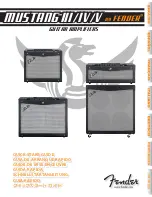
EN
GL
IS
H
3
Names and Function on Each Part
Top Panel
INSTRUMENT and MICROPHONE Channels
1. INSTRUMENT input: 1/4” phone jack
2. MICROPHONE input: Balanced input terminal with XLR jack. This
terminal doesn’t supply phantom power. 1-GND/2-HOT/3-COLD
3. 2 BAND EQ: Shelving EQ to cut and boost BASS and TREBLE fre-
quency range. Refer to the spec sheet at the end of this manual for
frequencies and levels.
4. VOLUME: controls the pre-amplifier level of each channel.
Effects and Master Section
5. CHORUS switch: turns CHORUS on/off of the INSTRUMENT chan-
nel.
6. CHORUS: controls the speed of the chorus effect of the instrument
channel. Turn this control to the right to increase the speed.
7. REVERB switch: turns REVERB on/off for both channels.
8. REVERB: controls each channel signal level sent to the REVERB
circuit. This function will be off at the “0” position.
9. AUX INPUT: for an external audio source. However, this is 1/8” ste-
reo input jack, stereo signals are mixed to mono. Use the volume
control of your portable player along with the volume control on the
amp to adjust the desired volume.
10. MASTER volume: controls the overall output level from this amplifi-
er. Doesn’t work for LINE OUTPUT.
11. POWER indicator: This LED will light when amp power is activated
by the POWER switch.
Rear Panel
12. POWER switch: turns the power on/off. Before you turn on the pow-
er of the amp, make sure that the VOLUME and MASTER knobs are
set to 0. When you are not using the amp it should be turned off.
13. AC INLET: Connect the included AC power cable to this connector.
Only use this amp with the voltage indicated on the panel.
14. LINE OUT: 1/4” phone jack outputs line level signal coming from pre
MASTER. You may plug in a mixing console, an external powered
speaker, or a recording device.
Troubleshooting
1. The power supply cannot be switched ON.
• Check that the power cable has been connected correctly.
• Try plugging it into a different power supply socket and see if the
same problem occurs.
2. The power supply can be turned ON, but no sound is
produced.
• Check that the guitar and microphone have been connected cor-
rectly.
• Remove the effects between the guitar and the amplifier and check
to see if no sound is produced.
• Replace the shielded cable and check to see if no sound is pro-
duced.
• Check to see if the volume on the guitar is set to “0”.
• Check to see if the microphone switch has been turned ON.
• Check to see if there are batteries in the guitar. If there are, check
that they are OK.
• Use a different guitar and see if no sound is produced.
• Check to see if the volume on the amp is set to “0”.
3. Noise occurs
• Check to see if anything in the immediate vicinity is resonating or
banging against the amplifier to produce the noise.
• Check to see if the plug cover on the shielded cable is loose.
• Check that the string action (distance between strings and frets) is
correctly adjusted (not too low).
• Check to see if the guitar batteries are depleted.
• Is the microphone used as unbalanced? If so, noise occurs easily.
• Use another guitar, microphone, effects and cable to see if the same
noise is produced.
In the case of defects
This product has passed exhaustive inspections before being shipped
from the factory. Ensure that the above procedures are carried out when
a problem is thought to exist. Contact your dealer in the unlikely event
that an abnormality occurs during use. Also, ensure that the symptoms
of the problem are explained in detail when requesting repairs in order to
facilitate swift handling.
Summary of Contents for Troubadour T30II
Page 1: ......
Page 2: ......
Page 6: ...4 IBANEZ 1 2 3 4 5 6 7 8 9 10 11 12 13 14 15 16 17 18 19 20...
Page 24: ...22 Ibanez 1 2 3 4 5 6 7 8 9 10 11 12 13 14 15 20 16 17 18 19 1 2 3 4 5 6 7 8 9 10 11 12 13...
Page 25: ...23...
Page 28: ......






































